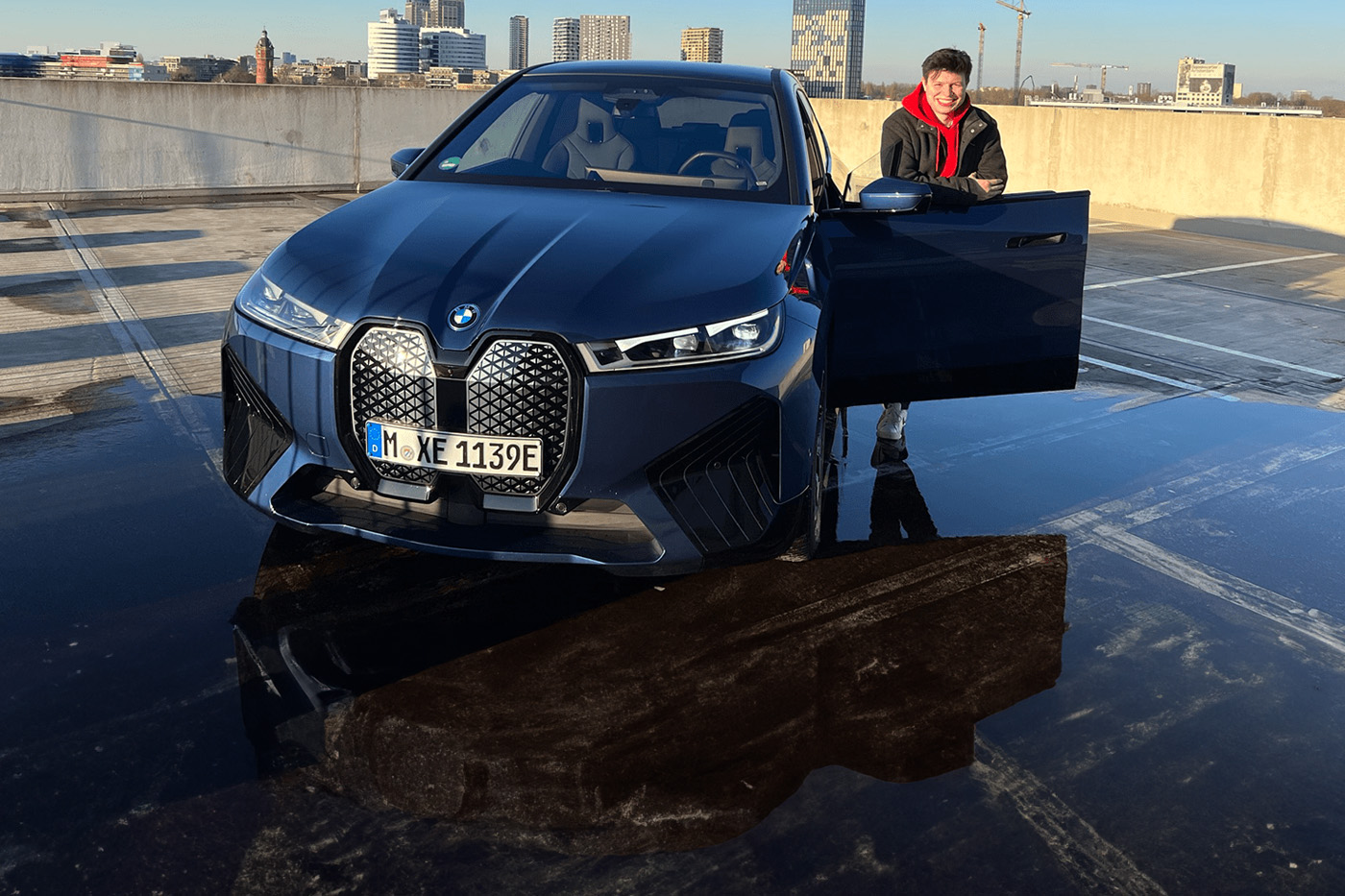
A road trip with the BMW iX xDrive50
After various trips in and around Munich, we drove to Amsterdam in one day and back to Munich two days later. Since we already tested the BMW iX xDrive50, this report will therefore not only be about the car on the long haul but also about our experiences with the charging infrastructure over this busy European route.
Unusual kidney grille design
The design of the iX is one of those things that takes some getting used to. The proportions are unusual, and the body is somewhat reminiscent of the silhouette of a pear. At first glance, the long bonnet and imitation radiator grille do not suggest an electric drive system; the rear is massive at the bottom and becomes much more delicate towards the top. But the more you look at the car, the more pleasing the design becomes, and by the end of our journey, I quite liked the rear end – but I’ll probably never be impressed with the imitation grille. In a way, this is another parallel to the i3: its design is also very unconventional, but it becomes more pleasing over time.
Spacious interior
In the interior, there are further references to the i3: the dashboard is slightly offset and seems to float, and there is no need for an overly massive centre console. Instead, there is still room for a small travel bag between the driver and passenger. The iX feels a bit like a living room on wheels. The back seat is especially comfortable: solid thigh support, princely legroom and enough airy space above passengers’ heads. This is made possible in part by the wheelbase, which at three metres is exceptionally long for a vehicle that is “only” 4.95 metres long. It feels much shorter when driving, thanks to rear-axle steering. The space in the rear of the car comes at the price of a relatively small boot: 500 litres big-ish, but still not much for a vehicle of this size. If you fold down the seats, you have a space of 1,700 litres. There is plenty of room for skis, as the centre seat can be folded away individually.
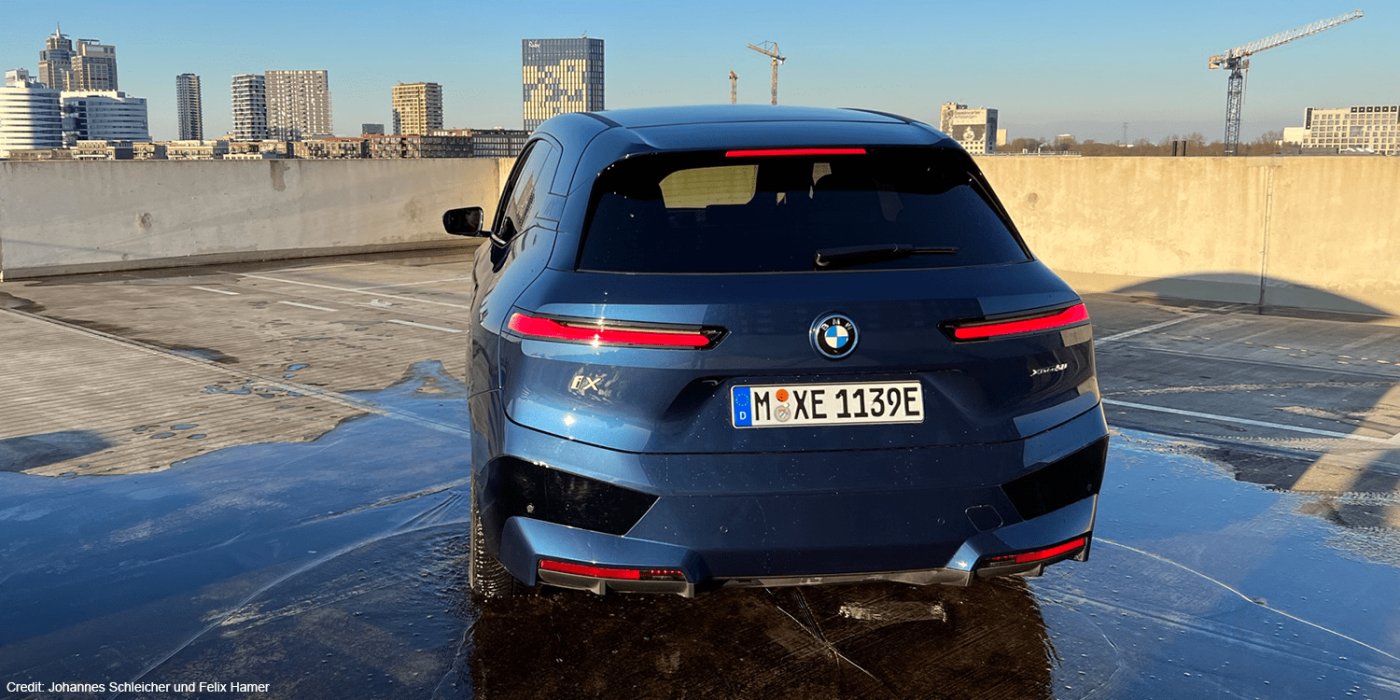
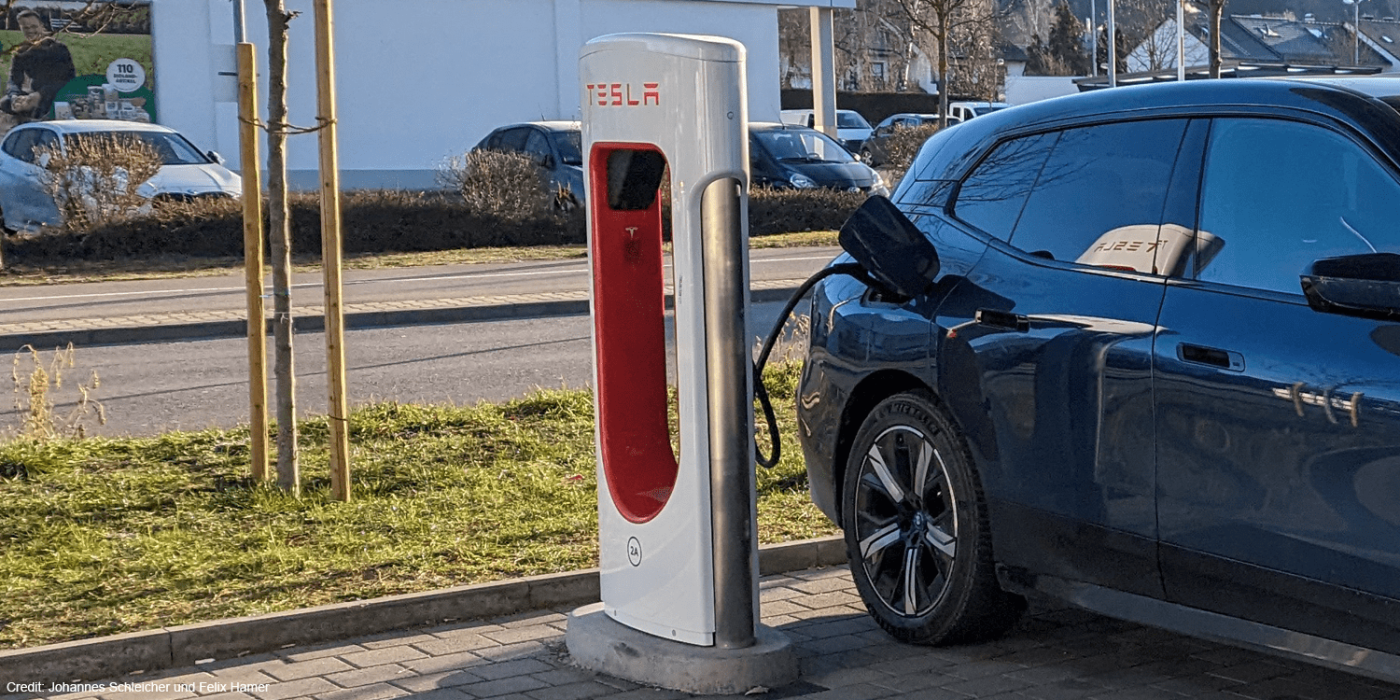
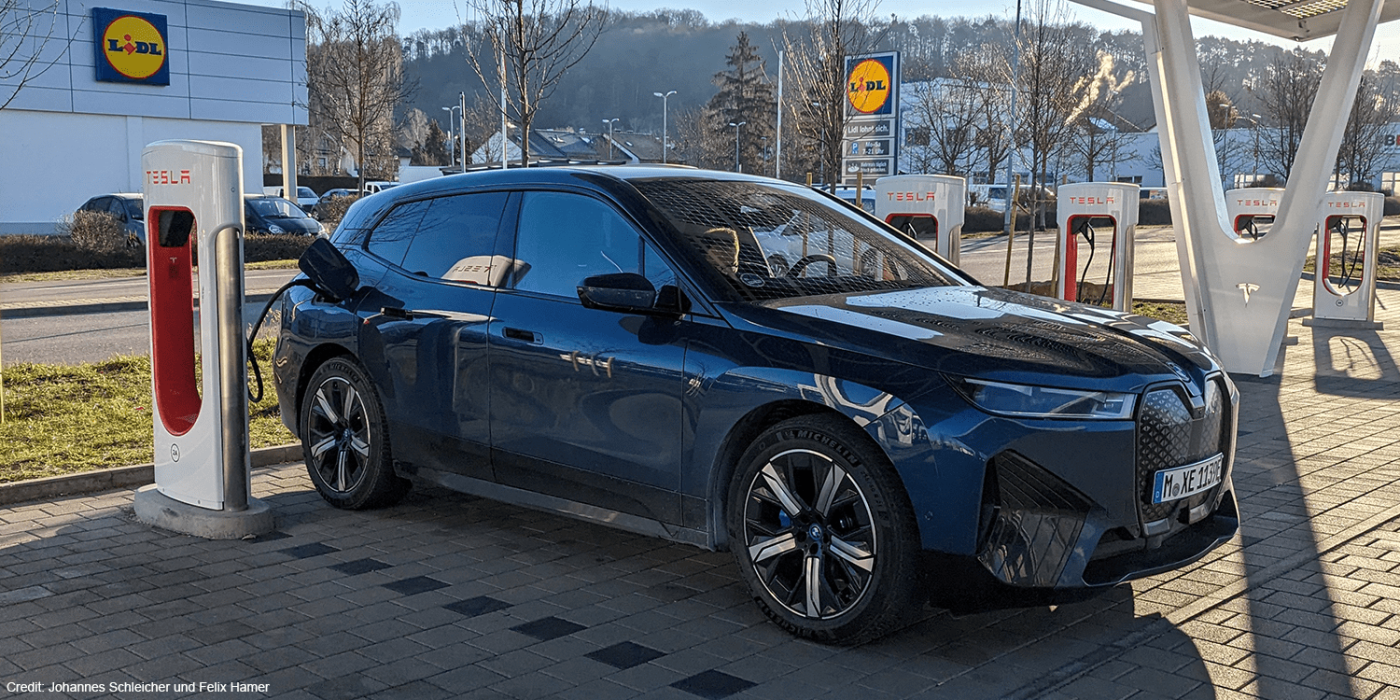
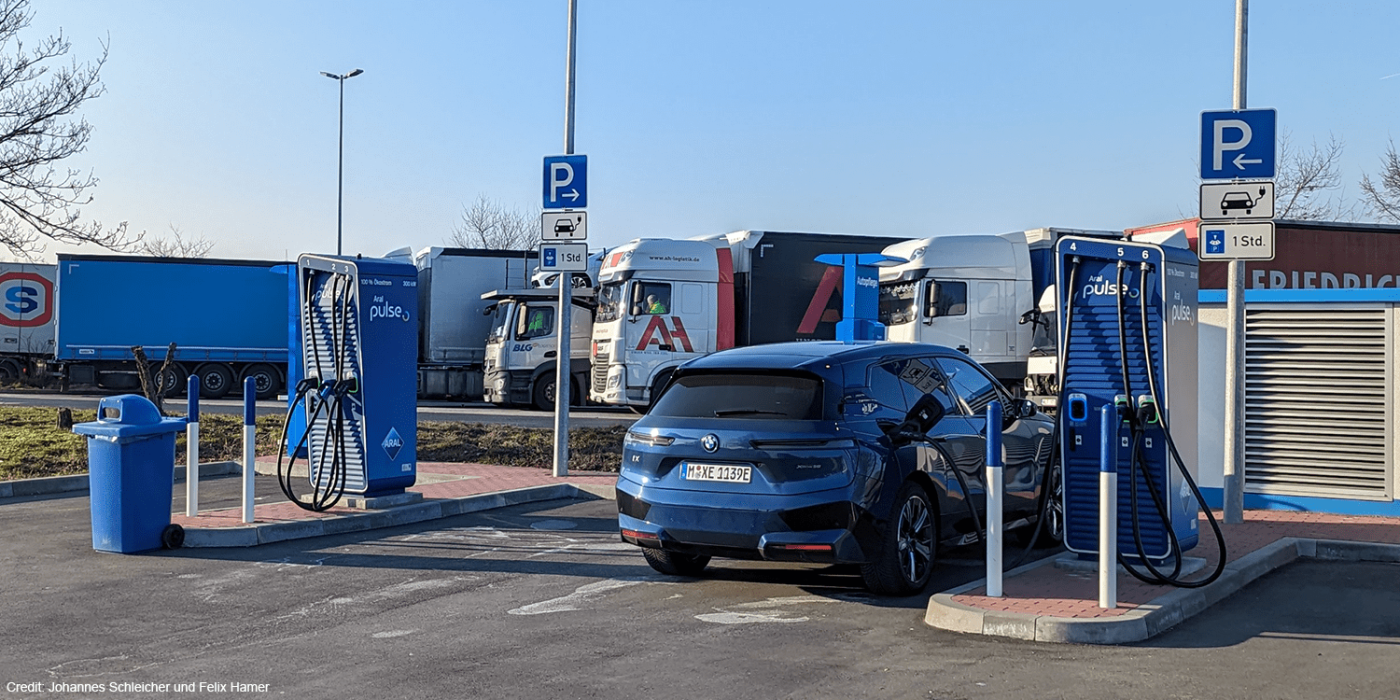
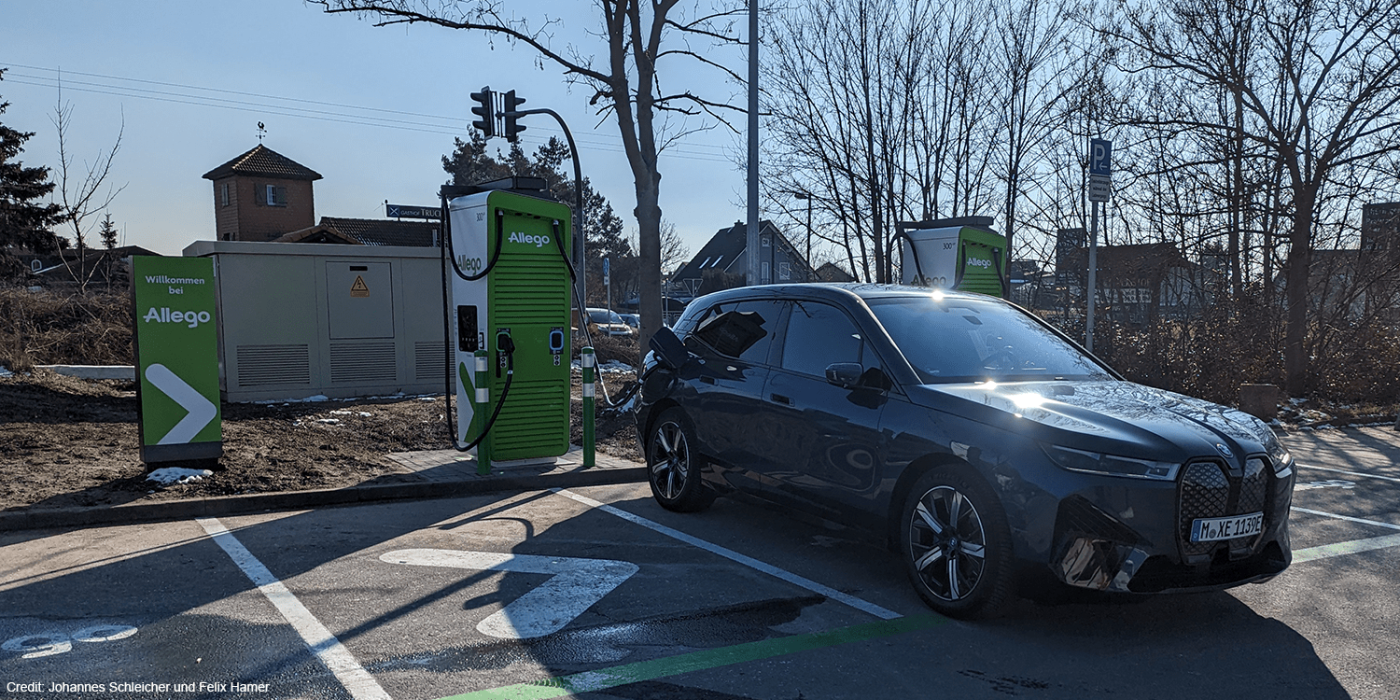
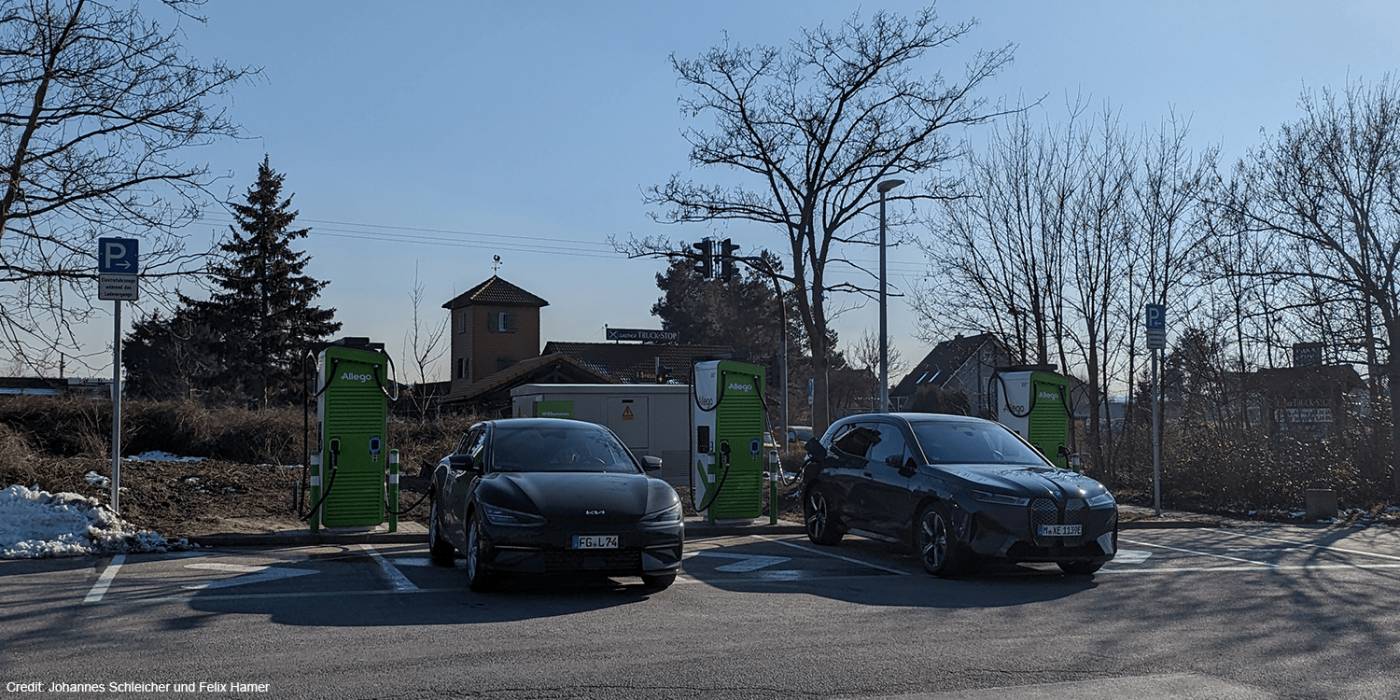
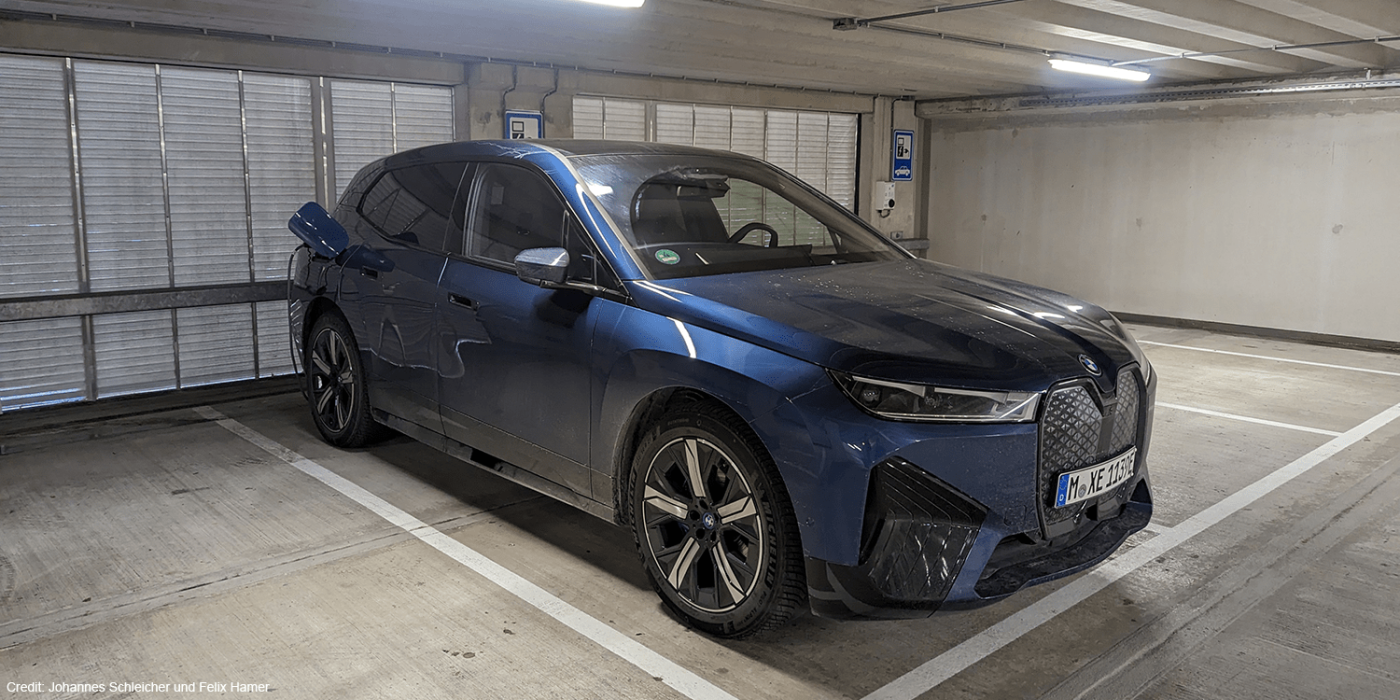
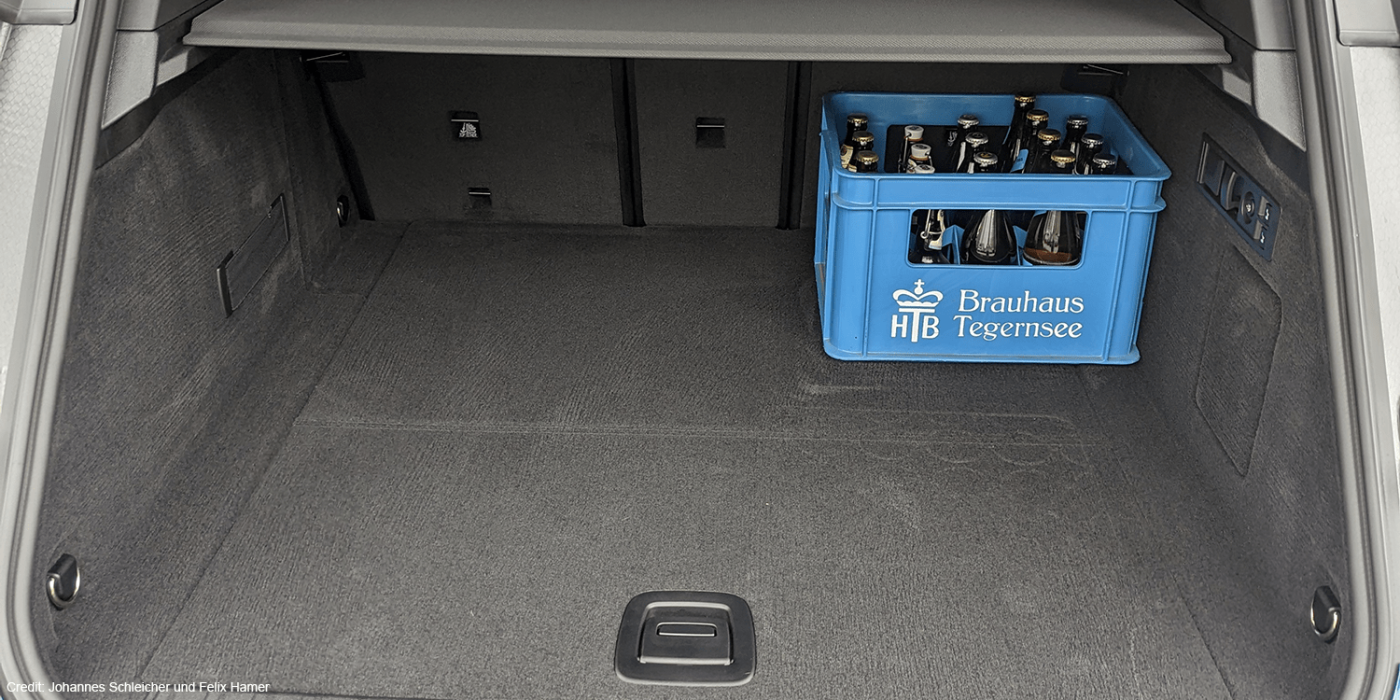
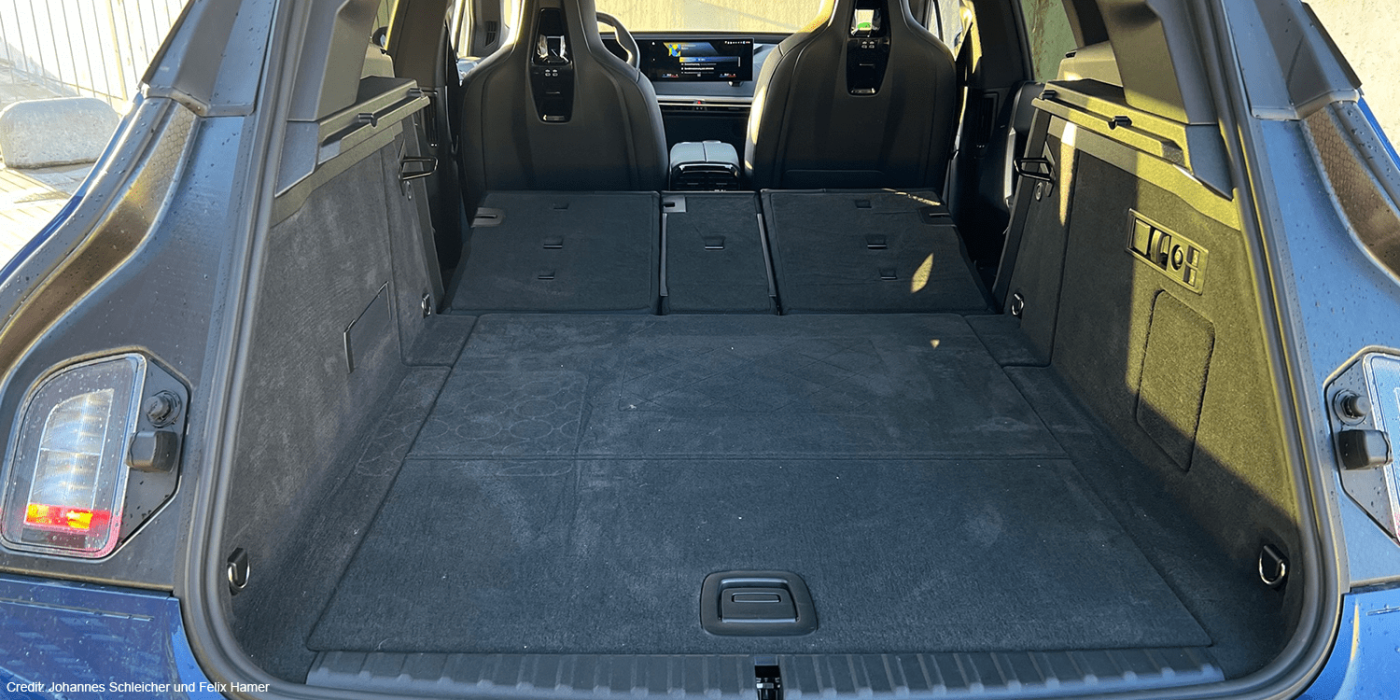
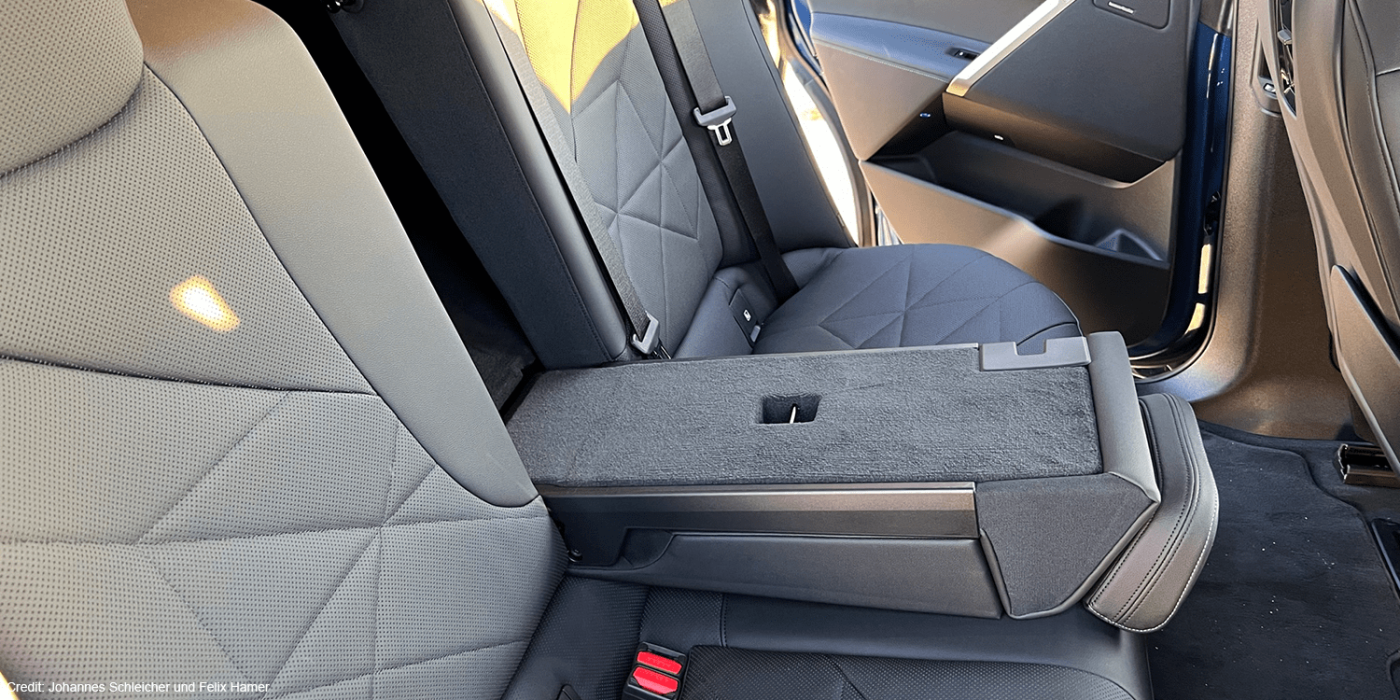
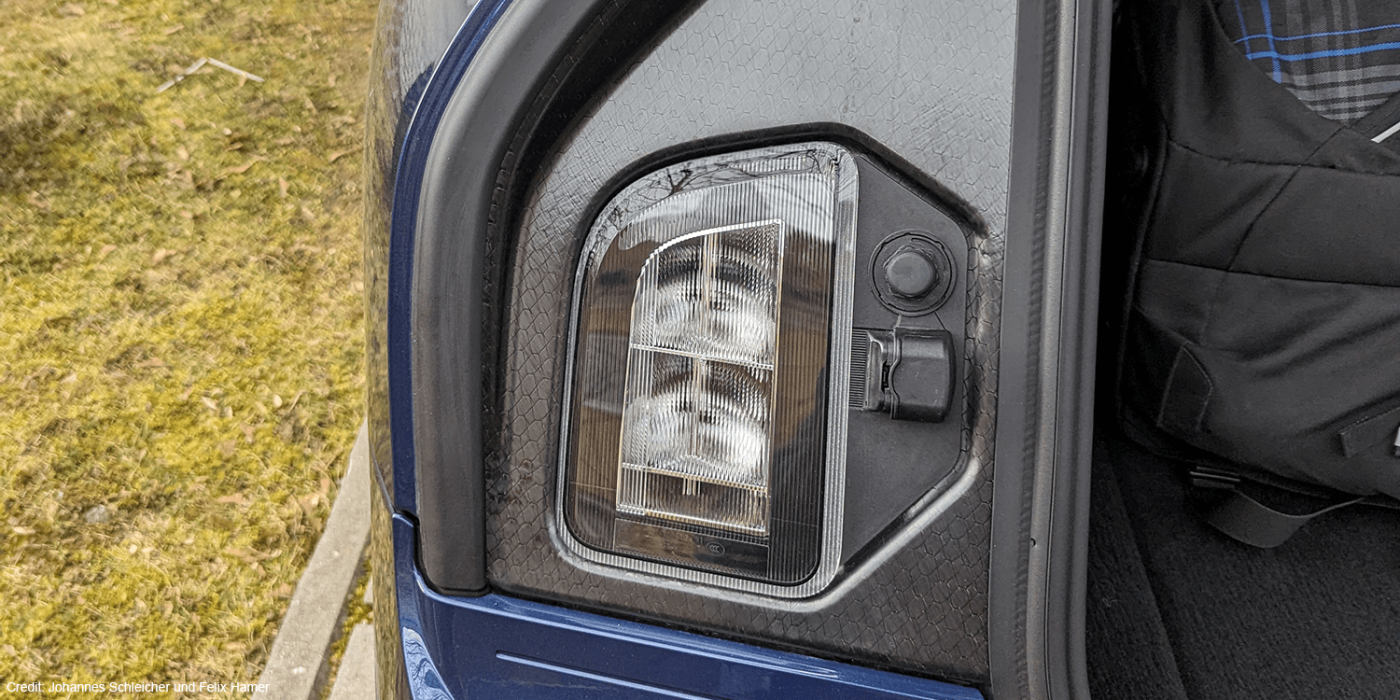
We made our first charging stop at the Supercharger Leonberg near Stuttgart to obligatorily try out just how well the Tesla charging station accepts the BMW. It works wonderfully and at full power, although activating the charging point via the Tesla app can be a bit awkward. It is much more convenient with a charging card or with Plug&Charge or Autocharge solutions (identification of the car directly via the plug, without a charging card or app). At Tesla, this feature is unfortunately reserved for Tesla models.
A comfortable home on wheels
Even though our test car surged forward with the power of 523 electric horses, the iX is definitely not a sporty car. The 2.5 tonnes of unladen (!) weight simply is too unwieldy in tight turns; the seating position is very comfortable but also much too far from the road, and more lateral support wouldn’t have done any harm either. But the iX is really excellent at comfortably covering long distances.
In one week of testing, we covered a total of 2,000 kilometres, most of it in two days, driving from Munich to Amsterdam and back again. In other electric cars with a long range, I often longed for charging breaks just to get out of the seat. But in the BMW, you don’t want to get out of the car, and even after many hundreds of kilometres, passengers sit comfortably in any of the seats. Not only are they all heated, but the corresponding armrests are too. If you had to, you would probably be happy to sit here for 800 kilometres at a stretch.
Its greatest enemy: air resistance
With 108.8 kWh net, the battery is more than ample, but so is its consumption. On the Dutch section our route, where 100 km/h is the order of the day, our average consumption was 24.2 kWh/100km. That still corresponds to a real range of more than 400 kilometres, but the BMW i4 manages that, too, with an 80 kWh battery and an almost identical electric drive system. At 130 km/h, as is only allowed here in Germany, the range shrinks to 300 kilometres, so our overall average for the entire tour was 32 kWh/100km. But we also enjoyed the possibilities still allowed on the German autobahn and occasionally used the maximum speed of 203 km/h.
To the iX’s credit, it must be noted that the driving conditions are, of course, totally relevant: The thermometer almost never climbed above freezing during our entire journey, and we always kept the interior toasty warm. In summer, more range will be possible – certainly at least 50, and probably even an extra 100 kilometres. Nevertheless, if you really want to drive a lot of very long distances, you’d be better off with a more streamlined car.
We made our second charging stop at the Hilden motorway junction in Germany, which is about two-thirds of the way between Munich and Amsterdam. We stayed much longer than the car actually needed to. The pizzas in the adjacent bakery shop were simply too delicious, so we could only continue after an extensive meal break. Sometimes it’s not the charging process that determines the length of the break.
Charging: Getting the most out of 400 volts
In contrast to the VW Group or Kia/Hyundai, BMW does not (yet) rely on an 800-volt architecture but on the tried and tested 400 volts. Nevertheless, the peak charging power is an impressive 195 kW. The charging curve is not bad either, for a long time, it ranges between 150 and 180 kW, and from ten to 80 per cent takes exactly 35 minutes.
Cold is the enemy here, too. With a completely cooled battery, the charging power can drop to 50 kW and then does not rise above 90 kW in the course of the charging process. It is, therefore, essential to activate the battery heating (by entering a charging point into the navigation system). Unfortunately, we searched in vain for a button to manually activate the battery heating. The test car did not have the announced update with the option to preheat the battery at the touch of a button.
But we didn’t really need this function: during the two charging stops, the car was ready to continue the journey faster than the passengers.
Software: tidy and with an excellent operating concept
For a long time, software was regarded as the central weak point in vehicles made by established car manufacturers who were very good at building cars but had little experience as software developers. The iX’s infotainment system bears no hint of this issue; it runs smoothly, has a good charge planner, a neat Spotify integration and above all, has a safe, sophisticated operating concept and no touchscreen stuck lovelessly into the landscape. Turn-and-push controls are often considered old-fashioned, but anyone who has ever tried to operate a touchscreen in a moving and wobbling car quickly appreciates a turn-and-push control.
A real treat is the head-up display, which presents so much information so well that you rarely have to look at the central screen and can thus keep your eyes on the road at all times. Whether it’s navigation instructions or scrolling through Spotify playlists, the driver sees almost everything important through the windscreen and can operate the system from the steering wheel.
Always online, always informed
A pleasantly positive surprise was the myBMW app, which is a great help to the common car tester, as well as regular customers, and has a lot of great features. The pictures from the cameras inside and outside can be transferred directly to your smartphone; the vehicle can be located, pre-air-conditioned, or a route can be sent to the navigation system. It feels like there is almost nothing that the app cannot do. For us, it was particularly pleasant that we no longer had to photograph or manually note down consumption values because the app provided everything perfectly prepared, and we could even export the statistics on the charging processes to a .csv file. Many other providers could definitely take a leaf out of BMW’s book here.
Sign recognition: a model for the competition
The driver assistance systems were also very good. The iX keeps its lane and distance perfectly on normal motorways but is a little unsure on more curvy roads, as well as above 150 km/h. It also handles lane changes on its own on command by tapping the indicator lever. But what I found most impressive was actually the sign recognition. Compared to Tesla’s chronically dysfunctional sign recognition, the BMW system was a real boon. Not only does it pick up all the signs immediately and correctly – it also has a very good prediction that tells you of an upcoming speed limit or its removal. How many times have I hit the pedal at the end of road construction, only to have to slow down for the next construction site three kilometres later? That doesn’t happen with the iX, which predicts that another speed limit is coming soon and that it’s not worth accelerating too fast.
Once we arrive in Amsterdam, we simply plug in at the hotel. In Germany, one wall box charging station per hotel can be found, but in the Netherlands, ten or more charging points are quickly found. When it comes to destination charging, Germany’s neighbours to the northwest have a really good charging model.
We made our way back making charging stops at Soest (serviced by Aral Pulse) just over a hundred kilometres out of the Netherlands driving eastwards and Quirla (Allego) in the centre east of Germany before I got off at the Mitterteich, car station, which is not far from the Czech border. My co-pilot Johannes drove the last leg to Munich alone.
Range anxiety is so 2020
A road trip through Germany to the Netherlands is now just as easy with an electric car as with a combustion engine. Carrying several charging cards can make sense for better prices, but being stranded at a charging point because the charging card is not accepted is de facto no longer possible. Area coverage has also improved massively. Five years ago, it was actually difficult to find fast-charging stations in many areas of Germany. Two years ago, you could find CCS charging points everywhere, but for those with more than 300 kW, it took some planning.
Today, there are so many 300 kW fast chargers that our main criterion on this road trip was which charging stop had the best restaurant. It has almost become boring to drive long distances with electric cars; on the Munich-Amsterdam route and back, it took us just under an hour longer each way than it would have with a diesel vehicle, which could have safely driven the distance. With eight hours of pure driving time, that’s perfectly within reason.
BMW goes electric
BMW has also made some real changes. True, the Munich-based company is still sending mixed signals about its future course – for example, with a project for 100 hydrogen cars that are primarily intended to make Bavaria’s Twitter-happy minister Hubert Aiwanger happy. But the cars themselves speak a very clear language: BMW’s future is electric. Battery-electric. The time when electric mobility was treated like an eccentric alternative, marked by the initial lack of success of the i3, is definitely over. The iX is not only one of BMW’s best cars but also, overall one of the best electric cars on the market. BMW can do electric and now they just have to show that they can do it at affordable prices. At 124,000 euros, the price of our test car was quite steep.

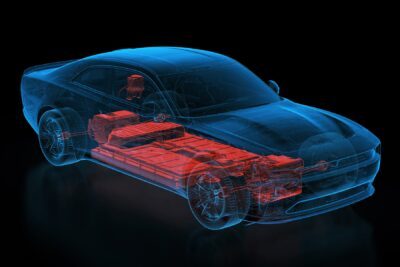
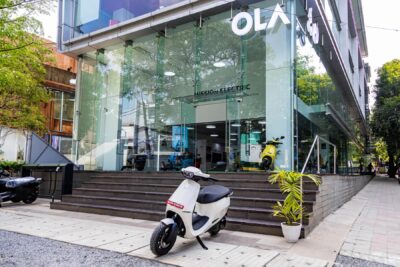
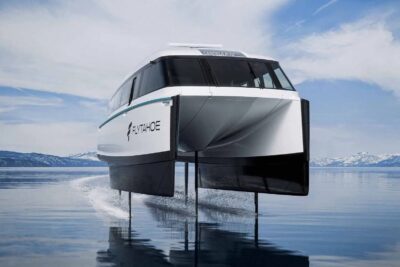
1 Comment